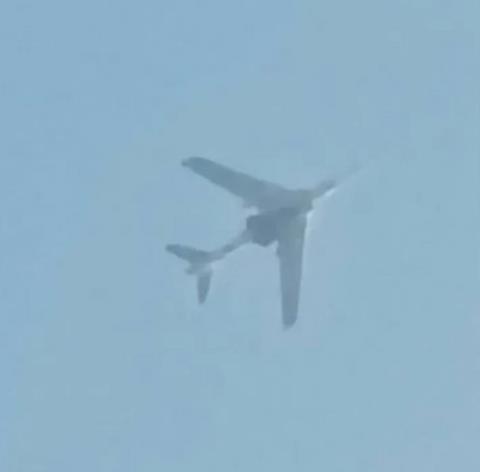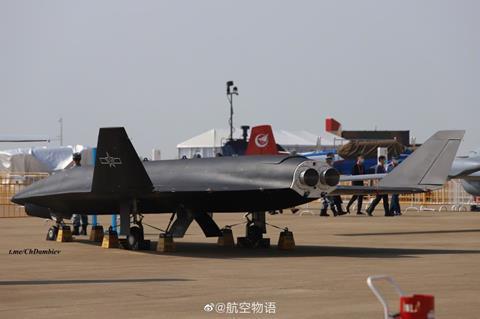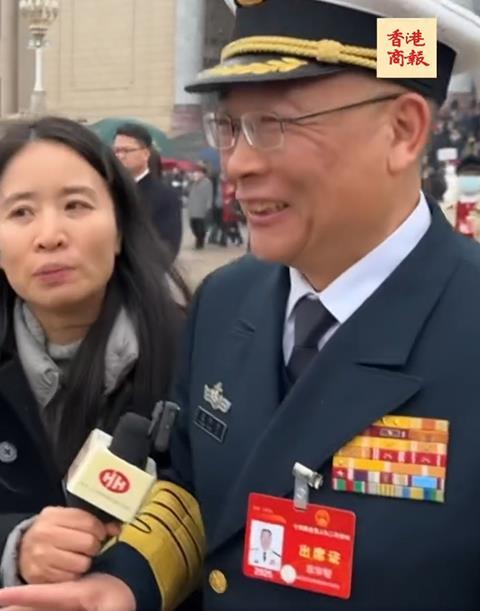The Xian H-6 and H-20 bombers have made headlines of late, but China’s efforts to build its long-range strike capabilities remain shrouded in mystery.
Blurry images recently emerged of a Chinese H-6 bomber carrying what appears to be a large, unmanned air vehicle of some sort under its fuselage. The provenance of the images – and whether they are even authentic – cannot be ascertained.

Initial speculation suggested the image is of a WZ-8, a supersonic UAV carried aloft by an H-6M. The WZ-8 made its debut on a truck during a 2019 military parade. A WZ-8 – which could have been a mock-up – also appeared in the static park of Airshow China in 2021.
Closer inspection of the images, however, may suggest a variant of the WZ-8 or a new type altogether. Where the WZ-8 has a straight trailing edge, the new images suggest a canted trailing edge. Additionally, while the WZ-8 has a full delta-wing configuration, the new image appears to suggest that the wing root starts further back on the vehicle’s fuselage.
If the images are genuine, one possibility is the MD-22 hypersonic vehicle. Like the WZ-8, the MD-22, first revealed at Airshow China in 2022, appears to have a straight trailing edge.
Another challenge with the new images is that the nose section of the carrier H-6 aircraft is blurred out. The left-side horizontal stabilizer is also suspiciously smaller than that on the right side – although this may be due to the aircraft’s attitude when the photo was taken.
In 2023, a leaked US government document – ostensibly from the National Geospatial Intelligence Agency - suggested the People’s Liberation Army Air Force (PLAAF) had set up an H-6W squadron using the delta-shaped WZ-8. The document stated that the WZ-8, an intelligence gathering asset, is dropped from the H-6W and then conducts a Mach 3 overflight of the target region at 100,000ft, providing real-time data for Chinese kill chains. It then lands at an airfield in China.
The document suggests its sensor suite comprises a synthetic aperture radar and electro-optical sensor for use in daylight conditions.

Irrespective of the specifics of the UAV that the H-6 was indeed carrying, the images highlight the importance of the H-6 platform across a range of missions, from naval strike in the form of the H-6K, to deployment of air-launched ballistic missiles from the H-6N, or carriage of high-performance drones aboard the H-6W.
However vague and questionable the new H-6 images may be, they are at least somewhat more tangible than recent news about the H-20, China’s long-running stealth bomber programme.
In early March, a reporter from a Hong Kong television station buttonholed Wang Wei, the deputy commander of the PLAAF, about the H-20. Wang was leaving the 14th National Committee of the Chinese People’s Political Consultative Conference, the country’s rubber-stamp parliament.
Wang, walking fast and clearly not in the mood for pesky reporters, stated that the H-20 is “worth the excitement” and will be “unveiled soon”. He offered nothing in the way of specifics.
Despite his brevity, Wang’s remarks were the first official word about the programme for some years. It is known that China is still engaged on the aircraft’s development: the Pentagon, in its annual assessments of the Chinese military, has said that work continues on the H-20.
In recent days, the H-20 again made the news, with US defence publications citing an anonymous Pentagon intelligence official as saying that the H-20 is “nowhere near as good” as US low-observable aircraft, and that China has encountered a number of engineering challenges on the programme. The official also stated that the H-20 is “not a concern” to the US military.
Given the paucity of open-source material about the H-20, it is impossible to know exactly how the unnamed official arrived at these perspectives. In pro-China defence chatrooms, which take great pride in China’s aerospace achievements, his remarks were quickly dismissed.

It is even possible that the US official’s remarks are intended to prod the Chinese side into making a revelation or two about the H-20 – and presumably why the US and its allies should be concerned about it.
Still, it is entirely reasonable to assume that China has encountered challenges with the H-20, much as all countries encounter challenges and setbacks with major defence acquisitions, particularly a programme as difficult as a stealth bomber.
The recent H-6 and H-20 news does little to advance the world’s knowledge about China’s military capabilities. It is certain that Beijing, having cracked down on social media sharing of military images and video, prefers it this way.
That the blurry H-6 photos and vague H-20 remarks – both from Wang Wei and the unnamed American official – were able to generate substantial media attention underlines the profound secrecy around Beijing’s airpower development.



















